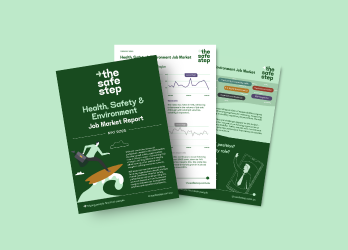Improving psychosocial safety at work: a guide for HSE professionals
Page Published Date:
September 20, 2023

Creating psychologically healthy and safe workplaces has become a burning imperative. With changes to regulations and codes of practice, employers now have a stronger obligation to manage hazards and prevent harms associated with bullying, work overload, burnout and a broad range of other risks.
In this blog we review the regulatory landscape and explore what’s working (and what’s not) and explore effective ways for HSE professionals to work on improving psychosocial safety at work .
Read on to learn how you can avoid litigation and harm, while at the same time contributing to positive wellbeing in the workplace.
Improving psychosocial safety at work – why is this important?
As the prominence of psychosocial safety has increased, it’s clear that HSE professionals (and their HR and Operations counterparts) are keen to make a positive difference to people’s lived experience of work.
At an enterprise level, organisations are also seeking to comply with health and safety regulations, avoid litigation, attract and retains top talent and creating a culture of care and empowerment amongst their workforce.
C-suite and boards are currently conscious of:
- The rising costs connected with work-related mental health conditions.
- Changes to codes and regulations relating to psychosocial hazards.
- A newly enshrined positive duty of care around prevention of sexual harassment.
- Recent litigation relating to reasonable hours of work.
- Recent prosecutions of companies and their directors, around workplace bullying and sexual harassment at work in VIC.
- A tightening of the types of claims which can be compensated under the workers comp regime in some jurisdictions.
- Winning the war for talent.
- Reputational risk.
- Social expectations evolving, with some ‘normalised’ work behaviours are coming under new scrutiny.
- A lack of clarity and expertise in this space.
Mental health: a burning imperative for employers
In a recent webinar hosted by The Safe Step, psychologist David Burroughs was quick to point out that the idea of managing psychosocial risk isn’t new, but that recent changes require a much sharper focus from organisations.
“Employers have always had a general duty of care, but now they are considering what else they can do to improve the lived experience of people at work,” Burroughs says. “What's changing now, is the need to be more sophisticated and to have a more systematic way of thinking about psychosocial hazards.”
Woolworths Director of Safety, Health and Wellbeing, Jane Bourke agrees. “COVID shone a light on mental health and new legislation is prompting us to think more deeply about areas such as long work hours, poor job control and job clarity,” Bourke says.
New psychosocial risk regulations and codes
As of 1 April 2023, amended Work Health and Safety Regulations require Australian employers to implement control measures for psychosocial risks. Safe Work Australia has defined a wide range of workplace psychosocial hazards and established a Model Code of Practice: Managing psychosocial hazards at work.
In addition, 2022 Respect@Work amendments to the Sex Discrimination Act 1984 establish a positive duty of care to eliminate sexual harassment and sex discrimination in the workplace. It requires employers to shift their focus to prevention, rather than responding only after an incident occurs.
Each state and territory is in the process of responding to these changes. Some have already produced their own codes of practice and/or updated WHS legislation. These include:
- NSW: Code of Practice: Managing psychosocial hazards at work
- QLD: Managing the risk of psychosocial hazards at work Code of Practice 2022
- TAS: Managing psychosocial hazards at work
- WA: Mentally Healthy Workplaces Codes of Practice
Other jurisdictions have amendments underway or have released guidance material about the increased importance of managing psychological health and safety in the workplace:
- ACT: Strategy for Managing Work-Related Psychosocial Hazards 2021-23
- NT: Work health and safety includes mental health
- SA: Psychological hazards & work-related stress
- VIC: Occupational Health and Safety Amendment (Psychological Health) Regulations
Make a difference, by making a start.
Don’t let complexity and confusion prevent you from acting. We all must start somewhere. While you won’t have all the answers just yet, you’re probably further along the process than you realise.
When it comes to creating mentally healthy workplaces, there’s no ‘one size fits all’ approach.
Using common language across the organisation is a good starting point.
Begin by pulling together existing data and tackling intuitively-informed areas of risk (known ‘hot spots’ within your business). Over time, begin to dive deeper, using different ways of thinking about risk.
Sophisticated multi-factorial approaches considering ‘up-stream stressors’ can be effective but take time to develop.
Invest wisely.
Experts caution against simplistic awareness and resilience programs, warning that trying to fix the worker (and not the workplace) has limited effectiveness.
“A lot of organisations are starting to recognise that all the money they've been investing in workplace mental health and awareness campaigns has not worked,” says David Burroughs. “In fact, it can do more harm than good.”
Burroughs suggests reviewing the evidence around effectiveness of popular workplace mental wellbeing interventions and the efficacy of mental health first aid, before committing funds to these sorts of initiatives.
Shed new light on issues.
Employment lawyer Steve Bell acknowledges psychosocial measurement and analysis is still in it’s infancy. “We’re in a new area. It’s OK that reporting focusses on activity, as opposed to efficacy. This will develop over time,” he says.
Bell has spoken to many inspiring boards and executives who are keen to take action, but don’t feel like they can trust the data they are being presented with. “There’s a sense of unease. “They don’t have the full picture,” he says
Instead of rushing for statistical perfection, he suggests thinking of ways to get a better handle on lived experience of employees. Respect@Work, for example, tells us one in three women suffer from sexual harassment at work. Simple math indicates the scale of this problem, however many WHS dashboards would paint a misleading picture.
Existing metrics are useful, but further work is required to shed light on the problem.
“Employee sentiment surveys might indicate that a hazard exists, but without detail around the duration, intensity and impact, they are insufficient to assess psychosocial risk.” explains Burroughs.
“You need multiple data points to really understand the risk,” agrees Jane Bourke, who sites absenteeism, turnover, grievances/complaints, listening sessions and other qualitative data as other pieces of the puzzle.
Considering risks associated with employee personas and employee lifecycles can be another useful way of thinking about risks.
Ensure top-down meets bottom-up.
Psychologist David Burroughs believes the best results come from taking multi-factorial approach and dovetailing top-down tactics with a bottom-up approach.
“Every staff member wants to tell you what's wrong and what they want to do to fix it. But are we giving them not just permission, but a mechanism to enable that to happen? Are we equipping our leaders with the capability to actually listen to and understand that information; and somewhere to report those psychosocial hazards or issues?” he asks.
Bottom-up approaches to managing psychosocial hazards
- Educate people about workplace factors that get in the way of people’s experience of work.
- Create clear, trusted mechanisms for people to report issues e.g. Woolworths is investigating ways to report customer aggression towards staff in real time, at the point of sale.
- Codesigned solutions, developed in close collaboration with workforce
- Support leaders as first line of defence
Top-down approaches to managing psychosocial hazards
- A coordinated cross-functional approach from HSE, HR, operations and leadership teams.
- Psychosocial health dashboards.
- Formal psychosocial risk diagnostics
- Deep dives into problematic areas that not only identify hazards, but also evaluate and respond to risks.
Find the right people for the job.
Our understanding of psychosocial safety at work has evolved rapidly in recent years. Given the pace of change, many work health and safety teams are not adequately prepared for the task ahead.
“The number of people that exist with the skill sets and capability to managing psychosocial safety in a sophisticated way, are as rare as a unicorn wearing a blue dress,” says Aaron Neilson, CEO of The Safe Step. “Organisations are now grappling with how to grow people internally to support their strategies. Strong competition exists when it comes to attracting external talent in this field.”
Some teams are investing in professional development activities such as the Canadian Mental Health Association’s Psychological Health and Safety training course. The UNSW is also in the process of developing a short course on managing psychosocial risk.*
Others are bring-in experts such as Steve Bell and David Burroughs to help them navigate the legal complexities and adhere to evidence-based best-practice.
How can we help?
We assist organisations to search for and secure people with the capabilities and experience to properly manage psychosocial risk in the workplace.
We also work with a range of senior consultants who can develop and implement psychosocial risk strategies across a range of white and blue collar workforces.
As Australia’s leading recruitment and search consultancy specialising in Health, Safety, Environment and Wellbeing, we can assist in scoping the project, understanding your resourcing needs and help connect you with the right HSE people to deliver with impact.
Resources
Identification & assessment:
Recent research:
Job design:
*Note: The Safe Step cannot attest to the quality and efficacy of the tools, resources and courses mentioned in this article. The links provided are for information purposes only and we encourage you to do your own research and due diligence prior to using.




